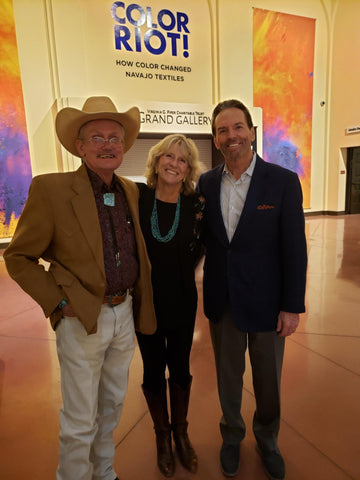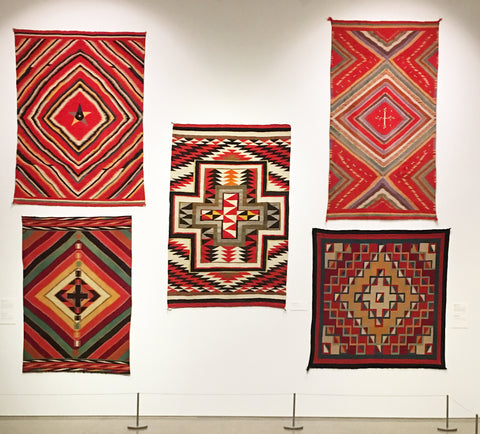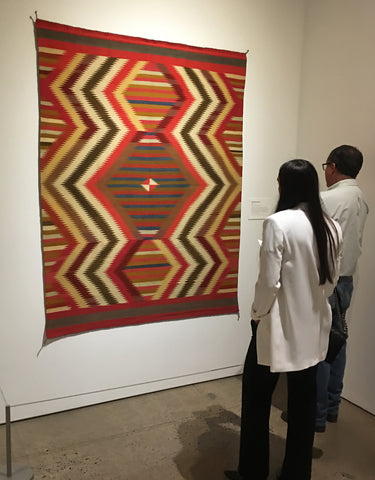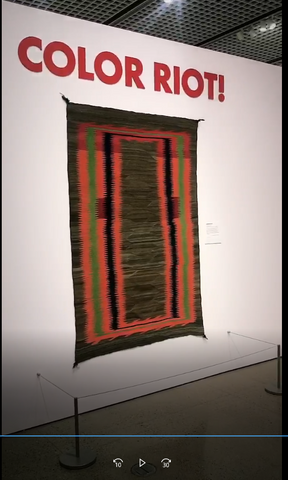Nizhoni Ranch News

From Floor to Loom - Preserving the Navajo Heritage
The Navajo Sandpainting Weaving is ranked among the Navajo tribe’s best known and best loved art forms. The original Navajo dry painting is traditionally performed for religious or medicinal purposes; it is a sacred practice. Sandpaintings are used in ceremonies designed to summon supernatural forces, they represent the Navajo’s religious world and are customarily part of ceremonies that will heal and restore a patient that is out of balance.
HASTEEN KLAH
The Navajo Sandpainting Textiles: an art form that owes its existence to Weaver, Artist, and Medicine Man Hasteen Klah (also spelled Hastiin Klah, and Hosteen Klah, 1867-1937). He began his training in the traditionally female craft of weaving with his mother and sister in the 1880s. He first began to learn the Navajo medicine ways – chanting and sandpainting – from his uncle. In learning the Nightway ceremony, Klah worked under the guidance of Laughing Singer and Tall Chanter. While most Navajo singers can master only one or two complete chants, Klah mastered at least eight. Among the ceremonies which he mastered were the Hailway, the Mountainway, the Nightway, the Windway, and the Chiricahua.
Hasteen had seen decades of unending efforts by the US Government and missionaries to transition the Navajo into the mainstream and adopt Christianity. Hasteen felt that the future of Navajo culture and religion was in danger, and yearned to preserve it.
IT BEGINS
In 1911 Hasteen Klah wove a blanket of Yei Be Chei dancers which portrayed sacred masks. Local singers felt that his was sacrilegious and demanded that Klah have a ceremony to expel the evil and that he destroy the weaving. Instead, Klah sent the weaving to Washington and experienced no negative effects.
In 1917 Klah took Franc Newcomb, trader Arthur Newcomb’s wife, to a Nightway ceremony. After the witnessing the ceremony, she became passionate about helping Klah preserve the traditions in as many media as possible. She attempted to draw from memory the designs from the sandpaintings which were used in the ceremony. She was unsuccessful and Klah sketched them for her in pencil. Newcomb then made these into watercolor reproductions and hung them in her bedroom so that the other Navajo would not be offended. After seeing that no punishment occurred, Klah then did an additional 27 paintings for her.
In 1919 Klah began to weave sandpainting rugs which were based on the chants he was qualified to sing. His first sandpainting weaving was a whirling log design from the Nightway ceremony.
Hasteen Klah with one of his Shootingway sandpainting tapestries at the Newcomb’s trading post, Navajo, New Mexico, ca. 1927. Photograph probably by Arthur or Frances Newcomb.
Over the years, Klah worked with a number of non-Indian scholars and allowed them to record his songs, ceremonies, stories, and sandpaintings. His only Navajo student – Beaal Begay – died in 1931 , so much of his knowledge of ceremony was not passed on in the Navajo traditional way. However, Klah and his nieces, Gladys and Irene, wove more than 70 sandpainting weavings between 1919 and 1937, preserving those ceremonial sandpaintings for the future.
One of the Anglos who worked with Klah was Mary Cabot Wheelwright (introduction through the Newcombs) who founded the Museum of Navajo Ceremonial Art in 1937. She had been permitted to record many of Klah’s songs and erected the museum to preserve his medicine knowledge and his sacred objects.
The museum is now known as the Wheelwright Museum. The Museum displayed many of his drawings and paintings of sand paintings, as well as his sandpainting weavings. The Wheelwright is no longer actively involved in the study of Navajo religion, however it maintains growing, world-renowned collections that document Navajo art and culture from 1850 to the present. It also presents changing exhibitions on traditional and contemporary Navajo and other Native American arts.
Getzwiller Historic Collection: Yei Be Chei : GHT 2215
This sand painting ceremony is protected by a border of arrow fletchings on all sides, Yei Dancers prepare to dance in a healing ceremony. Talking God with all of the feathers on his head wears a deer pelt as a sash and carries a weasel skin. The dancers are all male with the exception of the female with the square head in the center. The male dancers are adorned with fox tails hanging from their skirts. Calling God is seen at the other end with brown feathers on his head. All are wearing collars made of spruce.
This is an exceptional weaving and was featured in our Woven Holy People exhibit. You can see the exhibit guide here.
It is available for purchase, call Beth or Robin for pricing: 520-455-5020.
| Style | Yei / Yei Be Chei |
| Weaver | Unknown Navajo |
| Date | circa 1930s |
| Size | 5′2″ x 3′11″ (1.57M x 19M) |
| Item # | GHT 2215 |
To view all Sand Paintings available for purchase click here
- Beth Barth

You Little Beauty!

- Beth Barth
Spider Rock : Home of Spider Woman
Sacred Spider Rock, Canyon De Chelly, Navajo Nation
Spider Woman and Spider Rock
According to Navajo legend, Spider Woman lives at Spider Rock in Canyon De Chelly. She was first to weave the web of the universe. She taught the Navajo how to weave, how to create beauty in their own life and to spread the "Beauty Way" teaching of balance within the mind, body & soul. On the other hand Spider Woman has a bit of a dark side. But let's start off with the bright.
In the Navajo creation story, the first world was small and pitch black. There were four seas and an island. In the very middle of the island was a single pine tree. Ants, dragonflies, locusts and beetles lived there and made up the Air-Spirit People of the first world.
The second world was known as blue, where life was given to Spider Woman & Spider Man. Only their inner spirits or souls were made. Their physical bodies were made later to contain their spirits when they evolved into future worlds.
In the third world the holy ones advised Spider Woman that she had the capabilities of weaving a map of the universe and the geometrical patterns of the spirit beings in the night sky. At first she did not know what they meant, and was not told how it could be done. Curiosity became her energy and driving force to learn to weave as the holy ones instructed.
On a beautiful day when she was out on the land, exploring and gathering food, she came upon a small young tree. She touched it with her right hand and wrapped her fingers around one of its branches. As she was letting go, a string streamed out the center of her palm and wrapped around the tree branch. She was not quite sure what the string was. At first she shook her hand to release the string, but it would not break free. She thought if she kept wrapping the string around the branch it might let go.
Spider Woman started maneuvering and manipulating the string into various shapes. At this particular moment, she knew this was the weaving the holy people instructed her to do. Immediately she broke the string with her left hand without hesitation. She sat and thought carefully about how to use her new gift. For the rest of the day she sat close to the tree and wrapped the string into various patterns on other branches of the small tree.
The holy ones heard about Spider Woman's new talent and came to visit her. During the visit the holy ones instructed Spider Man to construct a weaving loom and also create the tools used in the various processes of weaving. At this time Spider Woman began to sing the weaving songs, given to her by the holy ones. The songs empower the weavings and the weaving tools.
Dine (Navajo) of today live in the fourth world, known as the "Glittering World". Young weavers are instructed to find a spider web in the early morning, glistening with sunlight and sparkles. They are told to place the palm of their right hand upon the spider's webbing without destroying or damaging the web. At that moment Spider Woman's gift of weaving enters the young weaver's spirit, where it lives forever.
Spider Woman's dark side. Navajo elders warn young children that Spider Woman is always on the look out for mischievous and disobedient children. When she finds them, she spins them tight with her web and takes them to the top of Spider Rock. There she boils and eats them. Their left over bones melt in the sun which create the white bands at the very top of Spider Rock. Yikes. Kids, be on your best behavior!

Cara Gorman, Master Navajo Weaver, close enough to Spider Rock to see the white bands

Elsie Bia, Master Navajo Weaver, near Spider Rock

Nizhoni Ranch Gallery Master Weavers, near Spider Rock
- Beth Barth

Navajo Textiles Across the Pond
One of our favorite clients in the UK decorated a room using Farrow & Ball Paint Company colors and a weaving from the Getzwiller Navajo Churro Collection. He submitted the photo to Farrow and Ball and they published it in one of their color collections! Thanks for sharing Douglas!
- Beth Barth

Weaving a Navajo Rug - Beginning to End
Elsie Bia preparing her loom for her next weaving - 2019. Times have changed - but over all Navajo weaving has remained the same. We don't know yet what style she will weave - but sure it will be fabulous! Go Elsie!
Navajo weaving never ceases to amaze us - even after all these years!!!
We often think about the early weavers and how incredible it is that they created magnificent art under the harshest of conditions with the simplest of materials. Tree limbs for looms, their sheep for the wool, hand carved tools to spin and weave and natural elements such as flowers and trees to dye the wool. Organic from beginning to end.
Many clients ask if weavers follow a pattern - and if not how in the world do they create such beautifully complex designs that are a perfect mirror image? Our answer is simple: Spider Woman. She taught the Navajo how to weave, how to create beauty in their own life and to spread the "Beauty Way" teaching of balance within the mind, body & soul. The gift of Spider Woman lives in every Navajo weaver.
How do weavers come up with their designs? Some weavers we work with tell us they were inspired by a photo, others say the design lives in their mind and a few say the designs come to them in their dreams.
For the last several years Elsie Bia has come to Nizhoni Ranch for special events and to weave live in person for our clients and visitors. To see Navajo weaving in person is extremely rare. We are appreciate that Elsie shares her gift with us.

Elsie preparing her loom for the opening of the Nizhoni Ranch Woven Holy People Exhibit 2016

Live weaving at Nizhoni Ranch Gallery

Elsie's weaving close to completion

Elsie's final product - Hero Twin Yei, with Spider Rock, home of Spider Woman in the background. (Sorry - this one has gone to a new home)
Click here to view available weavings by Elsie Bia!
- Beth Barth

Heard Hits It Out of the Park!
Color Riot! How Color Changed Navajo Textiles
Through September 3, 2019
Color Riot! How Color Changed
Navajo weavers’ individualism and flair for experimentation is vividly expressed in textiles from the last quarter of the 19th century. The textiles are rooted in ideas and events the weavers experienced between 1863 and 1868, the hard years of their imprisonment in the Bosque Redondo, and their subsequent return to a reservation. During this time, weavers saw examples of the design system of Hispanic textiles and acquired new materials such as aniline dyes and Germantown yarns that touched off their experiments with color and design. Commercial products at trading posts sparked additional design ideas for weavers. This was a time when outside market influences were at a low point. The old indigenous trading networks had been disrupted, woven garments were being replaced with commercial cloth and traders had not yet developed design constraints of the rug market that developed in the early 1900s. During this time of great change, as the Navajo rebuilt their flocks and repaired the devastation of Bosque Redondo, weavers had an unprecedented freedom to experiment.
Change has always been a hallmark of Navajo textile design, with the weavers’ individualism to a greater or lesser degree a continuing theme. Today, Navajo textiles are viewed as art with the singular vision of the weaver appreciated and applauded just as the vision of an artist working in the Euro-American artistic tradition has always been recognized.
Click here to view our weavings that are part of this show




Manta Serape
Circa: 1860-1865
57" x 75.5"
PC 258
Call for Pricing
520-455-5020
Navajo Twill Double Saddle Blanket
Circa: 1890's - 1900
35" x 53"
Call for Pricing
520-455-5020
SOLD!

Pictorial - Great Star - Germantown Yarn
Circa: 1880's
62" x 83"
SOLD

Transitional Optical
Circa: 1890
61" x 87"
Call for Pricing
520-455-5020
SOLD!

Double Saddle Blanket
Circa: 1880-1890
28" x 48"
Call for Pricing
520-455-5020

Serape - Rio Grande Saltillo Style
Circa: early 1880's
PC 35
Call for Pricing
520-455-5020

3rd Phase Chief Blanket
Circa: 1880's
56" x 78"
PC 278
Call for Pricing
520-455-5020

Transitional
Circa: 1880 - 1890's
61" x 89"
GHT 2150
Call for Pricing
520-455-5020

Saxony Blanket
Circa: 1875
52" x 77"
PC 254
SOLD!
- Beth Barth

Congratulations to Dos Cabezas Wineworks!
Dos Cabezas Wineworks, one Sonoita's local wineries has won "Best of Show", "Best Red Wine" & "Best Non-Traditional Red Blend" for their 2015 Aguileon in the 2018 azcentral.com Arizona Wine Competition!
Quite an honor, but frankly we are not surprised. The small family run winery headed by Todd and Kelly Bostock have been making award winning wines for more than a decade. Their 2015 Aguileon scored 93 points - JamesSuckling.Com.
Their tasting room is casual and welcoming. A great way to start a day of wine tasting - or start of a wine tasting weekend! In addition to fantastic wine, Todd and Kelly offer accommodations conveniently located next door to their wine tasting room at 3248 Hwy 82, Sonoita AZ.
Make it a weekend of weavings and wine. Both Nizhoni Ranch Gallery and Dos Cabezas Wineworks are located in the heart of the Sonoita Wine Country, just 45 minutes South East of Tucson.
Todd and Kelly Bostock of Dos Cabezas Wineworks in the high desert in Sonoita, Arizona. (Photo by Pat Shannahan)
- Beth Barth

Dye Master at Work!
Master weaver and dye artist Helen Bia was hard at work yesterday. We had the rare opportunity to see her dye in real time.

Step 1 - make the dye

Step 2 - add the wool and simmer

Step 3 - let the wool cool and sit to absorb the dye

Step 4 - check the color intensity

Step 5 - once the desired color is achieved, rinse the wool and let dry.
Making natural dyes and hand dying wool in incredibly time consuming. Very few weavers today take the extra time and effort to hand dye their wool.
It is a family tradition in certain weaving families along with "secret" family dye recipes.
Thank you Helen for giving us a glimpse into a day in the life of a Master Navajo Weaver.
Below is the final product!
THREE TURKEY RUIN: VEGETAL DYED NAVAJO WEAVING :
GLORIA BIA : CHURRO 1597
$ 3,500
- Beth Barth

























